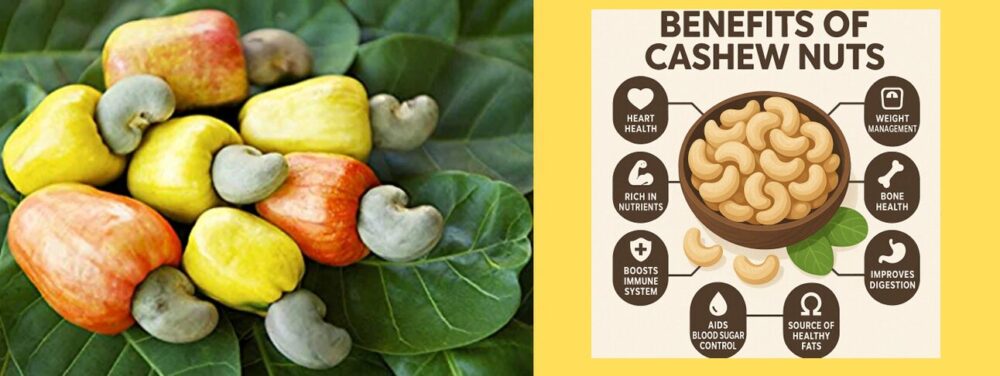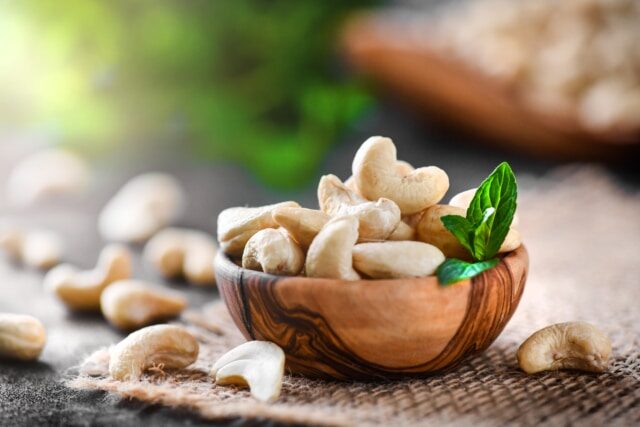Benefits of Cashew Nuts

Cashew nuts, often considered a delightful snack, are more than just tasty treats. These kidney-shaped nuts, which come from the cashew tree native to Brazil, offer a wide range of health benefits. Whether eaten raw, roasted, or used in cooking, cashews can contribute significantly to a healthy diet and lifestyle. Let’s explores the numerous benefits of cashew nuts, including their nutritional value, impact on heart health, contribution to bone strength, and potential in managing weight and blood sugar.
Nutritional Value

Cashew nuts are rich in essential nutrients. They are an excellent source of healthy fats, particularly monounsaturated and polyunsaturated fats, which are beneficial for heart health. Cashews also provide a good amount of plant-based protein, making them a valuable food for vegetarians and vegans. In addition, they contain important vitamins and minerals such as magnesium, zinc, iron, phosphorus, and vitamin B6. These nutrients are crucial for maintaining various bodily functions, including immune support, energy production, and nerve function.
Heart Health
Benefits of cashew nuts One of the major benefits of cashew nuts is their positive impact on cardiovascular health. The healthy fats found in cashews help lower bad cholesterol (LDL) and increase good cholesterol (HDL), reducing the risk of heart disease. Moreover, the magnesium content in cashews supports healthy blood pressure levels, further protecting the heart. Regular consumption of cashew nuts in moderation has been linked to a lower risk of heart-related conditions.
Bone and Muscle Support
Cashews are a rich source of magnesium and phosphorus, which are essential for bone development and maintenance. These minerals help in building strong bones and teeth and play a key role in muscle function. Magnesium also helps regulate calcium balance, which is important for nerve function and muscle contraction. Including cashew nuts in the diet can support overall skeletal health, especially in aging populations.
Weight Management and Blood Sugar Control
Despite being high in fat, cashews can be beneficial for weight management. The healthy fats, fiber, and protein in cashews promote a feeling of fullness, which may help control appetite and reduce overall calorie intake. Additionally, the natural sugars in cashews have a low glycemic index, meaning they have a minimal impact on blood sugar levels. This makes them a suitable snack option for individuals with diabetes or those trying to manage blood sugar.
Antioxidant Properties
Cashew nuts are also rich in antioxidants such as vitamin E and selenium, which help protect the body from oxidative stress and inflammation. These antioxidants play a role in preventing chronic diseases like cancer and aging-related disorders. The presence of certain plant compounds in cashews also contributes to their anti-inflammatory effects.
Cashew

Cashew (scientific name: Anacardium occidentale) is a tropical evergreen tree that produces the cashew seed (commonly known as cashew nut) and the cashew apple. Here’s a detailed overview covering its origin, cultivation, and other aspects:
🌱 ORIGIN & HISTORY
- Native Region: Northeastern Brazil.
- Spread by: Portuguese explorers in the 16th century.
- From Brazil, cashew was taken to India, Mozambique, and other parts of Southeast Asia and Africa.
- Main cultivation countries today: India, Vietnam, Côte d’Ivoire, Nigeria, and Brazil.
🪴 BOTANY & DESCRIPTION
- Scientific name: Anacardium occidentale (family: Anacardiaceae).
- Tree type: Small to medium-sized evergreen tree, up to 12 meters tall.
-
Parts produced
:-
Cashew apple
: Fleshy, sweet, and pear-shaped; edible but perishable. -
Cashew nut
: Kidney-shaped seed, encased in a hard shell with caustic resin.
-
🌍 CLIMATIC REQUIREMENTS

-
Climate: Tropical/subtropical (20–30°C), frost-free zones.
-
Rainfall
: 1000–2000 mm annually; well-distributed. -
Soil
: Well-drained sandy or laterite soils; pH 4.5–6.5. -
Sunlight
: Full sun is essential for good yield.
🌿 CULTIVATION PRACTICES
1. Propagation
- Usually by seeds, grafting, or air-layering.
- Grafted plants bear fruits faster (~3–4 years).
2. Planting
- Spacing: 7–10 meters apart.
- Time: Typically at the start of the rainy season.
- Fertilization: Organic compost and balanced NPK fertilizers are recommended.
3. Flowering & Fruiting
- Flowering starts in winter or early dry season.
- Fruits mature in 2–3 months.
- The cashew nut is harvested first; the apple may be processed or eaten fresh.
4. Harvesting
- Time: Around February–May (varies by region).
- Nut is separated and dried before processing.
🏭 PROCESSING
- The raw nut has a toxic shell oil (cashew nut shell liquid or CNSL), which must be removed by roasting or steaming.
- The kernel is then:
- Dried, peeled, graded, and packed for consumption or export.
🌰 CASHEW PRODUCTS

-
Cashew Nut
– Snack, ingredient in dishes. -
Cashew Apple
– Juice, vinegar, fermented into liquor. -
Cashew Nut Shell Liquid (CNSL)
– Used in industrial resins, varnishes, paints. -
Cashew Butter
– Like peanut butter, made from cashew nuts.
🌎 GLOBAL PRODUCTION LEADERS (2020s data)
| Country | Approx. Annual Production (MT) |
| India | ~700,000 |
| Vietnam | ~300,000 |
| Nigeria | ~250,000 |
| Brazil | ~150,000 |
💡 INTERESTING FACTS
- Cashews are not true nuts, botanically—they are seeds.
- The shell oil is highly caustic and used in brake linings and insecticides.
- The cashew apple, although often discarded, is rich in vitamin C.
Cashew Nut
Overview
Cashew nuts come from the cashew tree (Anacardium occidentale), native to Brazil, but now widely cultivated in India, Vietnam, Africa, and other tropical regions.
🎨 Color
- Raw cashew nuts (before roasting or cooking): Pale ivory or light beige.
- Roasted cashews: Light golden to brown, depending on the roast level.
- Coated/seasoned varieties (e.g., spicy, chocolate-covered): Vary in color depending on seasoning.
👅 Taste & Texture
-
Taste
: Mildly sweet, buttery, and slightly nutty. -
Texture:
- Raw: Creamy and slightly soft.
- Roasted: Crunchy with enhanced flavor.
- When ground: Smooth and rich, ideal for pastes or sauces.
🍛 Popular Dishes Using Cashew
Cashews are versatile in savory and sweet preparations:
🔥 Savory Dishes
- Kaju Curry / Kaju Masala: Rich, creamy North Indian curry made with ground cashews.
- Paneer Butter Masala: Cashew paste is used to make the gravy creamy.
- Biryani: Cashew nuts are fried and added for crunch and richness.
- Pulav & Fried Rice: Often garnished with roasted cashews.
- Thai and Asian Cuisine: Used in stir-fries (e.g., cashew chicken).
🍬 Sweets & Desserts Using Cashew
Cashews are key ingredients in many traditional Indian sweets and desserts:
🍮 Indian Sweets
- Kaju Katli: Diamond-shaped fudge made from cashew paste and sugar.
- Kaju Roll: Cylindrical cashew sweet often filled with pistachios.
- Halwa: Cashew halwa or added to suji (semolina) or carrot halwa.
- Payasam / Kheer: Garnished with ghee-fried cashews.
- Laddus: Often contain crushed or whole cashews.
🍰 Other Uses
- Cashew Butter: Creamy spread, a dairy-free alternative to peanut butter.
- Cashew Milk: Used as a vegan milk alternative.
- Vegan Cheeses: Made from soaked and blended cashews.
🌍 Availability
- Global Availability: Widely available in supermarkets, health food stores, and online.
- Forms:
- Whole (raw or roasted)
- Salted or unsalted
- Broken pieces (used in cooking or sweets)
- Cashew paste or butter
- India is one of the top producers and consumers (especially in Kerala, Goa, Karnataka, Maharashtra).
🥦 Nutrition & Health Benefits
- Rich in: Healthy fats, protein, magnesium, iron, and zinc.
- Good for: Heart health, bone health, and immune system support.
- Moderation is key: High in calories.
Cashew Benefits
Cashews offer a wide array of health benefits, including:
-
Heart Health
Cashew nuts are not only delicious and versatile, but they also offer several heart health benefits when consumed in moderation as part of a balanced diet. Here’s a detailed look at how cashews contribute to cardiovascular health:
🫀 1. Rich in Heart-Healthy Fats
- Cashews contain mostly unsaturated fats (about 82% of their fat content), including monounsaturated (MUFA) and polyunsaturated fats (PUFA).
- These fats:
- Help lower LDL (bad cholesterol).
- Raise HDL (good cholesterol).
- Improve blood vessel function.
✅ Healthy fat profile supports better lipid levels and overall cardiovascular health.
💖 2. Help Reduce LDL Cholesterol
- Studies suggest that regular intake of cashews can reduce LDL cholesterol and total cholesterol.
- This is due to:
- Presence of oleic acid (also found in olive oil).
- Low saturated fat content.
✅ Lower LDL reduces the risk of atherosclerosis (artery clogging).
🩸 3. Improve Blood Pressure
- Cashews are a good source of magnesium and potassium, both essential for blood pressure regulation.
- Magnesium relaxes blood vessels, helping reduce hypertension.
✅ Regular magnesium intake helps maintain normal blood pressure, reducing cardiovascular strain.
🧬 4. Antioxidant Protection
- Cashews are rich in antioxidants, including:
- Vitamin E
- Polyphenols
- Zeaxanthin
- These combat oxidative stress, which can damage blood vessels and heart tissue.
✅ Antioxidants reduce inflammation and protect against heart disease.
🧂 5. Naturally Low in Sodium
- Unlike many salted snacks, unsalted cashews are naturally low in sodium.
- Excess sodium is a major risk factor for high blood pressure and stroke.
✅ A heart-friendly snack when consumed unsalted or lightly salted.
🧡 6. Improve Blood Sugar Control
- Cashews have a low glycemic index and contain fiber and healthy fats.
- This helps stabilize blood sugar, reducing insulin spikes that can stress the cardiovascular system.
✅ Helps prevent metabolic syndrome and type 2 diabetes—both risk factors for heart disease.
🏃♂️ 7. Aid in Weight Management
- Though energy-dense, cashews can promote satiety due to healthy fats and protein.
- Studies show nut consumption is associated with lower risk of obesity and heart disease.
✅ Weight control is a key part of heart health.
✅ Summary: Heart Health Benefits of Cashews
| Benefit | How Cashews Help |
| Lower LDL, raise HDL | Unsaturated fats |
| Lower blood pressure | Magnesium & potassium |
| Protect arteries | Antioxidants |
| Improve circulation | Anti-inflammatory compounds |
| Support glucose control | Low glycemic, fiber |
| Help manage weight | Satiating nutrients |
⚠️ Precautions
- Portion control is key: 15–20 cashews (1 ounce) per day is ideal.
- Choose raw or dry-roasted cashews; avoid heavily salted or oil-roasted varieties.
- People with nut allergies should avoid cashews.
- Bone Strength
Cashew nuts are a nutrient-dense food that can contribute significantly to bone strength and health. Here’s a detailed breakdown of how cashew nuts benefit bones:
🦴 1. Rich in Magnesium
- Why it matters: Magnesium is essential for bone structure. About 60% of the body’s magnesium is stored in bones.
- Bone Benefit: It helps in calcium absorption and plays a critical role in converting vitamin D into its active form.
- Cashew Content: 100g of cashews provides around 82 mg of magnesium, contributing to stronger, denser bones.
🦴 2. High in Copper
- Why it matters: Copper supports the enzymatic cross-linking of collagen and elastin, two essential components of bone and connective tissue.
- Bone Benefit: Deficiency can lead to osteoporosis and brittle bones.
- Cashew Content: Cashews are exceptionally rich in copper—just a handful provides more than 100% of the daily requirement.
🦴 3. Contains Phosphorus
- Why it matters: Phosphorus is the second most abundant mineral in bones.
- Bone Benefit: Works alongside calcium to build and maintain bone mass.
- Cashew Content: Around 168 mg of phosphorus per 28g serving, supporting structural bone integrity.
🦴 4. Source of Plant-Based Protein
- Why it matters: Protein is essential for the repair and maintenance of bone tissue.
- Bone Benefit: Helps maintain bone density and muscle mass, both crucial in preventing falls and fractures.
- Cashew Content: Provides 5 g of protein per 28g (about 18-20 nuts).
🦴 5. Contains Vitamin K (in small amounts)
- Why it matters: Vitamin K helps in the regulation of bone mineralization.
- Bone Benefit: Supports the production of osteocalcin, a protein involved in bone building.
- Cashew Content: Though not very high, cashews do contribute a bit to daily Vitamin K needs.
🦴 6. Antioxidant Benefits
- Why it matters: Oxidative stress can accelerate bone loss.
- Bone Benefit: Cashews contain antioxidants like selenium and polyphenols that may reduce inflammation and oxidative damage to bone tissue.
🦴 7. Healthy Fats for Vitamin D Absorption
- Why it matters: Vitamin D is fat-soluble and essential for calcium absorption.
- Bone Benefit: The healthy monounsaturated fats in cashews may aid the absorption of vitamin D, indirectly benefiting bone health.
⚠️ Bonus Tip: Moderation Is Key
While cashews are bone-friendly, they’re also calorie-dense. A handful (about 28g or 18–20 nuts) per day is a healthy serving for most adults.
✅ Conclusion
Cashew nuts support bone strength by delivering:
- Magnesium → enhances calcium absorption
- Copper → builds bone matrix
- Phosphorus → mineralizes bones
- Protein → maintains bone and muscle
- Antioxidants → reduce bone loss from inflammation
- Healthy fats → help absorb vitamin D
They make an excellent addition to a bone-strengthening diet when eaten in moderation and as part of a balanced, nutrient-rich lifestyle.
- Immune System Boost
Cashew nuts are not only delicious but also beneficial for immune system health due to their rich nutritional profile. Here’s a detailed breakdown of how cashews support and boost the immune system:
🧬 1. Rich in Zinc — Immune Cell Production
- Zinc is one of the most essential minerals for immune function.
- Cashews are a good plant-based source of zinc, which:
- Supports the development and function of immune cells like T-cells and natural killer cells.
- Helps in wound healing and reducing inflammation.
- Plays a role in the activity of over 300 enzymes related to immunity.
💪 2. Contains Antioxidants — Fights Free Radicals
- Cashews contain antioxidants like:
- Vitamin E
- Selenium
- Polyphenols
- These antioxidants neutralize free radicals, reducing oxidative stress, which can weaken the immune response.
🩸 3. Copper Content — Supports Enzyme Function
- Cashews are very rich in copper, which:
- Helps form red blood cells.
- Plays a role in maintaining healthy blood vessels, nerves, and immune function.
- Assists in iron absorption, indirectly supporting energy levels and immune readiness.
🦠 4. Anti-inflammatory Properties
- The combination of healthy fats, antioxidants, and magnesium in cashews helps reduce chronic inflammation, which is linked to weakened immunity and disease.
🧠 5. Brain-Immune Axis Support
- Cashews contain magnesium and healthy fats (mainly monounsaturated), which are crucial for nerve function.
- A healthy nervous system supports the neuroimmune axis, the communication network between the brain and immune system.
🍽️ 6. Supports Gut Health (Indirect Immune Support)
- Cashews contain dietary fiber, which nourishes gut microbiota.
- A healthy gut microbiome is essential for:
- Regulating immune responses.
- Preventing overreaction (autoimmunity).
- Enhancing pathogen defense.
❤️ 7. Rich in Iron — Prevents Fatigue and Supports Immunity
- Iron deficiency can cause fatigue and impair immunity.
- Cashews provide non-heme iron, supporting:
- Oxygen transport.
- Immune cell energy.
✅ Bonus Benefits that Indirectly Help Immunity
| Nutrient | Immune Benefit |
| Vitamin K | Helps with healing and inflammation control |
| B-vitamins (especially B6) | Support energy production and immune metabolism |
| Protein | Supports production of antibodies and immune cells |
⚠️ Things to Keep in Mind
- Portion control is key — cashews are calorie-dense.
- Roasted, salted, or sugar-coated cashews may reduce the health benefits.
- For maximum immune benefit, choose raw or dry-roasted, unsalted cashews.
4. Eye Health
Cashew nuts offer several eye health benefits due to their rich content of antioxidants, vitamins, and essential fatty acids. Here’s a detailed breakdown of how cashew nuts support and protect eye health:
🥜 Eye Health Benefits of Cashew Nuts
1. Rich in Zeaxanthin
- Benefit: Zeaxanthin is a powerful antioxidant found in the retina, especially in the macula (the central part of the eye).
- How it helps:
- Acts as a natural filter of harmful blue light.
- Helps prevent age-related macular degeneration (AMD).
- Reduces oxidative stress in eye tissues.
2. High Levels of Healthy Fats
- Type: Monounsaturated and polyunsaturated fatty acids (like oleic acid).
- How they help:
- Promote good circulation, including to the eyes.
- Support the structure of the eye cell membranes.
- Help in the absorption of fat-soluble vitamins like vitamin A, essential for vision.
3. Vitamin E Content
- Benefit: Vitamin E is a potent antioxidant that protects cells from free radical damage.
- How it helps:
- Reduces the risk of cataracts and AMD.
- Protects the eye lens and retina from oxidative stress.
4. Source of Zinc
- Role in eye health:
- Essential for proper functioning of enzymes in the retina.
- Plays a key role in transporting vitamin A from the liver to the eye.
- Supports night vision and reduces the risk of AMD.
5. Copper-Rich
- Cashews are a great source of copper, which:
- Helps in maintaining the health of the optic nerve.
- Is involved in melanin production, which protects the eyes from UV damage.
6. Antioxidants & Phytochemicals
- Cashews contain flavonoids and polyphenols, which:
- Combat oxidative stress that can damage retinal cells.
- Slow down degenerative eye diseases.
🧠 Bonus Benefit: Supports Brain-Eye Connection
- Nutrients in cashews like magnesium and B vitamins enhance nervous system health, helping maintain a strong signal between the brain and the eyes.
👁️ Eye Conditions Cashews May Help Prevent
| Condition | How Cashews Help |
| Macular Degeneration | Through zeaxanthin, vitamin E, and zinc |
| Cataracts | Antioxidants and vitamin E reduce lens oxidation |
| Night Blindness | Zinc helps with vitamin A metabolism |
| Dry Eyes | Healthy fats improve tear production and lubrication |
📝 How to Include Cashews in Your Diet
- Raw or roasted (unsalted) as snacks
- In smoothies, energy bars, or trail mix
- Cashew milk or cashew butter (healthy alternatives)
- As a topping in salads and curries
⚠️ Note: Cashews are calorie-dense. Limit intake to 15–20 per day to avoid weight gain, and choose unsalted varieties to avoid excess sodium.
5. Weight Management
Cashew nuts, while energy-dense, offer a range of weight management benefits when consumed in moderation and as part of a balanced diet. Here’s a detailed look at how cashew nuts can support weight management:
🥜 1. Rich in Healthy Fats (Supports Satiety & Metabolism)
- Monounsaturated & polyunsaturated fats in cashews support heart health and may enhance fat oxidation.
- These fats increase satiety (fullness), helping reduce overall calorie intake during the day.
- Compared to saturated fats, healthy fats from cashews may support metabolic efficiency.
🍽️ 2. Promotes Satiety (Helps Control Appetite)
- Cashews contain protein (~5g/oz) and fiber (~1g/oz), which slow digestion and promote longer-lasting fullness.
- Eating them as a snack can reduce the likelihood of overeating later in the day.
🔥 3. Thermogenic Effect (Burning Calories)
- The digestive process of nuts is not 100% efficient: up to 10–15% of nut calories may not be absorbed, meaning you get fewer calories than labeled.
- Some studies suggest nuts may have a thermogenic effect, slightly boosting metabolic rate.
🧬 4. Rich in Nutrients That Regulate Metabolism
Cashews provide key nutrients that indirectly help with weight control:
- Magnesium: Involved in over 300 enzymatic reactions, including those related to fat and carbohydrate metabolism.
- Zinc: Supports hormone balance and leptin regulation, which affects hunger cues.
- Vitamin B6 and Iron: Support energy production and prevent fatigue, helping maintain activity levels.
📉 5. May Help Reduce Belly Fat
- Cashew consumption, like other nuts, is linked to lower waist circumference in observational studies.
- The monounsaturated fats may help mobilize fat from the abdominal area.
🧪 6. Low Glycemic Index (Stable Blood Sugar Levels)
- Cashews have a low glycemic index, meaning they don’t spike blood sugar levels.
- Stable blood sugar helps prevent energy crashes and sugar cravings, which can lead to better calorie control.
🧠 7. Improves Mood and Reduces Emotional Eating
- Cashews are rich in tryptophan, a precursor to serotonin, which can improve mood and reduce stress eating.
- Magnesium and healthy fats also play roles in mood stabilization, indirectly helping with better eating behavior.
⚠️ Important Considerations
- Portion control is critical: Cashews are calorie-dense (about 155–170 kcal per 1 oz / 28g).
- Avoid salted or fried varieties to prevent water retention and excess sodium intake.
- Stick to raw or dry-roasted varieties in controlled amounts (about 10–15 cashews per serving is a good start).
✅ Summary of Cashew Benefits for Weight Management
| Benefit | Mechanism |
| Satiety | Protein, fiber, and healthy fats |
| Metabolism boost | Magnesium, iron, fat oxidation |
| Appetite control | Stable blood sugar, nutrient density |
| Reduced calorie absorption | Some fat is not fully digested |
| Belly fat reduction | Healthy fats promote abdominal fat mobilization |
6. Skin & Hair Benefits
Cashew nuts are not only a delicious snack but also a rich source of nutrients that provide multiple benefits for skin and hair. Here’s a detailed look at how cashew nuts support skin health and hair growth:
🧴 Skin Benefits of Cashew Nuts
1. Rich in Antioxidants
- Vitamin E & Selenium: Cashews contain antioxidants like vitamin E and selenium which help combat oxidative stress, reducing wrinkles, fine lines, and age spots.
- Helps maintain skin elasticity and youthful glow.
2. Promotes Collagen Production
- Copper is a key mineral in cashews that aids in the production of collagen, which keeps skin firm and reduces sagging.
3. Fights Inflammation
- Contains monounsaturated fats and anti-inflammatory compounds that may help reduce acne, redness, and skin irritation.
4. Improves Skin Tone
- Nutrients like zinc, iron, and magnesium in cashews help boost blood circulation and oxygen delivery to skin, resulting in a healthier, brighter complexion.
5. Helps Prevent Skin Infections
- Zinc in cashew nuts supports the immune system and helps prevent bacterial skin infections like acne and eczema.
💇♀️ Hair Benefits of Cashew Nuts
1. Strengthens Hair Roots
- The copper content boosts melanin production, which not only helps maintain natural hair color but also strengthens hair roots and reduces breakage.
2. Promotes Healthy Hair Growth
- Cashews contain vitamin B-complex (especially B7 or biotin) and iron, both essential for healthy and strong hair follicles.
3. Prevents Hair Loss
- Zinc supports hair tissue growth and repair, and also keeps the oil glands around hair follicles functioning properly.
4. Maintains Scalp Health
- The presence of essential fatty acids and magnesium helps nourish the scalp, reducing dandruff, dryness, and flakiness.
5. Improves Hair Texture & Shine
- The monounsaturated and polyunsaturated fats in cashew nuts moisturize the hair shaft, improving softness, shine, and manageability.
🥜 How to Include Cashews in Your Diet for Skin & Hair Benefits
- Eat 5–10 cashews daily (unsalted and raw or lightly roasted).
- Add to smoothies, salads, curries, or nut butter spreads.
- Use cashew oil topically for both skin and scalp massages.
⚠️ Precautions
- Cashews are calorie-dense; moderation is key to avoid weight gain.
- People with nut allergies should avoid them.
- Always choose unsalted, unflavored cashews for maximum health benefits.
Cashew Nut Price
The price of cashew nuts varies based on grade, size, origin, and processing. As of recent market trends in India: Best Cashew Nuts in India are grown in Goa which is known as Kaju or Goan Kaju
- W180 (premium large size): ₹950–₹1200 per kg
- W240/W320 (common sizes): ₹700–₹950 per kg
- Broken cashews (lower grade): ₹500–₹650 per kg
Internationally, the price depends on processing standards, organic certification, and bulk supply.
Cashew Price
Here’s a comprehensive overview of cashew prices in India, covering availability (online and offline), leading producing states, quality, seasonal trends, sellers, and current offers:
🧾 1. Price Situation (Mid‑2025)
Wholesale / Farmgate:
- Raw cashew nuts in places like Kolar (Karnataka) trade around USD 0.93–1.76/kg, depending on region (e.g., Koppa or Goa) Freshela Exporters+2Ministry-Of-Nuts+2Samsons Traders+2Agritell+3Tridge+3The Times of India+3.
- Market sources report mandi wholesale prices at approximately ₹110–₹120/kg commodityonline.com.
Retail Kernels:
- Typical retail cashew kernels (edible) cost between USD 7.27–7.94/kg, or ₹602–658/kg in major cities such as Delhi & Mumbai Selina Wamucii.
Export/Import Prices:
- India’s export prices vary widely (2023–2024): USD 6.82–12.39/kg, depending on grade & size like W320 Tridge+1Samsons Traders+1.
- Import prices for raw cashews into India range from USD 1.05–2.13/kg cashewnews.in+15Tridge+15Tridge+15.
🌾 2. Production Zones & Quality
Leading Producing States:
According to recent data, top cashew‑producing states include:
- Maharashtra (~199,700 t)
- Andhra Pradesh (~127,200 t)
- Odisha (~121,300 t)
- Karnataka, Tamil Nadu, Kerala (~77–76 t)
- Others: Chhattisgarh, West Bengal, Meghalaya, Gujarat renub.com+10Agritell+10currentaffairs.adda247.com+10currentaffairs.adda247.com.
- Kollam (Kerala) is globally famous for cashew processing, handling ~800,000 t raw and exporting ~130,000 t kernels annually. Over 600 processing units are based here, earning the city the title “Cashew Capital of the World” en.wikipedia.org+2en.wikipedia.org+2en.wikipedia.org+2.
- Sindhudurg & Vengurla (Maharashtra): Known for GI‑tagged Vengurla cashew varieties (V1–V7) offering high yield, shelling %, and rich flavor. V2 variety offers ~24 kg nut yield per tree and 32% shell thickness en.wikipedia.org.
🏪 3. Offline vs Online Availability & Sellers
Offline (Mandis / Retail):
- Mandis in major cashew belts (Goa, Karnataka, Kerala) offer raw or lightly processed nuts at ₹110–120/kg commodityonline.com.
- Retail branded kernel packs—available in supermarket chains or dry‑fruit shops—typically range ₹600–700/kg, depending on grade/packaging.
Online:
- E‑commerce platforms (Finebuy , Amazon, BigBasket, Flipkart) offer branded raw/premium kernels (W180, W210, W240, W320 grades).
- Frequently available in 500 g or 1 kg packs with occasional offers like 10–25% discount, combo packs with other nuts.
- Seasonal promotions often coincide with festivals like Diwali/Christmas.
📉 4. Seasonality & Price Drivers
Seasonal Trends:
- Harvest season in major regions (Goa, Maharashtra, Karnataka): January–May—prices are usually lower due to supply influx.
- Prices often creep up post‑May, as inventory drops before next season.
Market Drivers:
- Climate disruption: South Goa and Koraput saw ~50% production declines in mid‑2025 due to erratic rains, pushing up prices for premium nuts to ₹200/kg, while low-grade disease‑affected nuts sold as low as ₹30/kg Ministry-Of-NutsThe Times of India.
- Livelihood crisis in Koraput (Odisha) tribal areas: crop losses caused premium-grade nuts to fetch ~₹200/kg but most poor-quality cashews only ₹30/kg The Times of India.
- Supply chain constraints: Post‑pandemic logistics delays and labour shortages in processing hubs like Kerala and Maharashtra increased internal costs and added to retail prices Ministry-Of-Nuts.
🧶 5. Quality Grades & Seller Types
Cashew Grades:
- Raw unshelled: Farmgate/mandi—used for further processing.
- Kernel grades: W180, W210, W240, W320, LWP, SWP, etc. Lower number = larger size (premium).
- Quality-linked price: e.g. W320 often trades at USD 3–4/kg export, retail higher domestically (~₹650/kg and above).
Seller Landscape:
- Producers & State Agencies: KSCDC (Kerala), Maharashtra cooperatives, DCCD support in Odisha/Tamil Nadu.
- Processing units in Kollam and Vengurla export most kernels.
- Traders and exporters in supply chain handling farmgate purchases, bulk kernel exports, and imports.
- Retailer brands: Nutty Gritties™, Veggies’n’More™, local regional brands; available online and in supermarkets.
📊 Summary Table
| Segment | Price Range | Quality / Notes |
| Raw (mandi/farmgate) | ₹110–₹120/kg | Unprocessed, variable moisture/kernel size |
| Retail kernels | ₹600–₹700+/kg | Branded W‑grade packs, premium size/nut |
| Export (USD/kg) | $6.8–12.4 | High‑grade kernels like W320, W240 |
| Import raw (USD/kg) | $1.05–2.13 | Often from Vietnam, Africa |
✅ Recommendations
- If you’re buying in bulk offline, seek mandi rates during harvest season (Jan–May) for best pricing.
- For online retail, compare seller reviews, check for fresh procurement/expiry dates, and use festive discounts.
- Look for GI‑tagged or ISO‑certified kernels for assured quality (e.g., Vengurla, Kollam‑processed).
- Monitor news around climatic events—production dips in Goa or Odisha spike prices quickly (e.g., ₹200/kg for premium grade).
- Contact local cooperatives in Maharashtra or Kerala for direct sourcing opportunities if interested in larger volumes.
📌 Recent Concerns
- Goa production dropped ~50% in mid‑2025 due to abnormal weather—urgent policy measures requested by MLAs mandiprices.inThe Times of India.
- Koraput’s cashew crop losses estimated over ₹30 crore—harvest failures lowered quality, impacting price & livelihoods The Times of India.
In short, cashew pricing in India depends heavily on season (lower during harvest), quality grade, region of sourcing, and recent weather disruptions. Premium kernels (W‑grades) drive export prices and retail costs, whereas mandi trade focuses on volume with thinner margins. Let me know if you’d like specifics on brands, online sellers or grade-wise comparisons!
Cashew With and Without Skin
Cashew nuts are typically processed to remove the outer shell and skin. Here’s a breakdown:
-
Cashew with skin
(also called testa) – less common, sometimes used in traditional medicine but not widely consumed -
Cashew without skin
– what we usually eat; safe, creamy, and tasty
Raw cashews (unshelled and unroasted) must never be consumed without proper heat treatment due to urushiol, a skin-irritating toxin.
Cashew Fruit
The cashew fruit is a fascinating and unique part of the cashew tree (Anacardium occidentale), a tropical evergreen native to Brazil but now widely cultivated in various tropical regions around the world, especially in India, Vietnam, Nigeria, and Ivory Coast.
🔸 Structure of the Cashew Fruit
The cashew fruit consists of two distinct parts:
- Cashew Apple (False Fruit)
- Cashew Nut (True Fruit)
1. Cashew Apple
- Botanical nature: It is a pseudofruit, meaning it is not a true fruit but a swollen pedicel (stem) that supports the nut.
- Appearance: The cashew apple is pear-shaped or bell-shaped, and ranges in color from yellow to red.
- Size: Usually about 5–10 cm long.
- Texture: Smooth skin with soft, juicy, and fibrous flesh.
- Flavor: Sweet, tangy, and slightly astringent due to tannins.
- Nutritional content:
- Rich in vitamin C (about 5 times more than oranges),
- Contains antioxidants, minerals, and some sugars.
- Uses:
- Consumed fresh or juiced.
- Fermented into wine, vinegar, or alcoholic beverages (like feni in Goa, India).
- Used in jams, chutneys, and preserves.
2. Cashew Nut
- Botanical nature: The true fruit of the cashew tree – a kidney-shaped drupe attached to the bottom of the cashew apple.
- Shell: Hard, double-layered, containing toxic substances like anacardic acid (a skin irritant).
- Processing:
- The shell is roasted or steamed to remove the toxic oils.
- After careful cracking and peeling, the edible cashew kernel is obtained.
- Uses:
- Eaten raw, roasted, salted.
- Used in cooking, baking, and making products like cashew butter, cashew milk, and vegan cheese.
- Nutritional content:
- High in healthy fats, protein, magnesium, copper, and iron.
- Contains antioxidants and plant sterols.
🔸 Botanical and Agricultural Information
- Scientific Name: Anacardium occidentale
- Family: Anacardiaceae (same family as mango and poison ivy)
- Height of Tree: 6–12 meters
- Pollination: Mostly by insects
- Harvest Season: Varies by region (e.g., March–May in India)
- Yield: One tree can produce hundreds of fruits annually.
🔸 Interesting Facts
- The cashew nut must always be processed before consumption due to the toxic oil in its shell.
- The cashew apple is highly perishable, limiting its commercial export.
- Cashew trees are often used to prevent soil erosion due to their strong root systems.
Cashew Nut Price per Kg
Here’s a quick snapshot of cashew nut price per kg as of 2025 (India average retail):
| Grade | Price per Kg (INR) |
| W180 | ₹1000–₹1200 |
| W210 | ₹900–₹1100 |
| W240 | ₹800–₹950 |
| W320 | ₹700–₹900 |
| Broken | ₹500–₹650 |
Prices vary by location, season, and demand. Premium organic or export-quality cashews cost more.
Cashew Price per Kg
Cashew kernel prices differ from raw cashew nut (RCN) prices, which are usually sold in large volumes:
- RCN Price (2025 India): ₹100–₹140/kg (unprocessed, in-shell)
- Processed kernel: ₹700–₹1200/kg (ready-to-eat, based on grade)
Factors affecting price:
- Harvest quality
- Global demand
- Processing costs
- Export-import policies
Cashew Tree

The cashew tree (Anacardium occidentale) is a tropical evergreen tree known for producing the cashew nut and the cashew apple. Native to northeastern Brazil, it is now cultivated widely in tropical regions around the world, especially in India, Vietnam, Nigeria, and the Ivory Coast, which are among the largest producers of cashew nuts.
🌳 Botanical Description
- Scientific Name: Anacardium occidentale
- Family: Anacardiaceae (same family as mango and poison ivy)
- Type: Tropical evergreen tree
- Height: Typically grows 6–12 meters (20–40 feet) tall, but dwarf varieties (used in commercial farming) grow around 4 meters.
- Lifespan: Can live up to 30–40 years with good care.
🌿 Leaves
- Type: Simple, alternate, leathery
- Shape: Obovate (egg-shaped), broad, with a smooth edge
- Size: 4–22 cm long
- Color: Glossy green on the upper side, lighter below
🌼 Flowers
- Inflorescence: Terminal panicles (clustered)
- Color: Greenish-yellow to pink
- Size: Small, about 6–8 mm
- Sex: Both male and bisexual flowers occur on the same tree (monoecious)
🍎 Fruit & Nut
Cashew produces two types of edible parts:
1. Cashew Apple (false fruit)
- Botanical term: Hypocarp
- Appearance: Pear-shaped, shiny, red or yellow
- Texture: Juicy and fibrous
- Taste: Sweet to slightly acidic
- Use: Eaten fresh, juiced, fermented into alcohol, or used in jams (popular in Brazil and India)
2. Cashew Nut (true fruit)
- Location: Grows at the end of the cashew apple
- Shell: Hard and kidney-shaped, contains toxic oil (anacardic acid, similar to poison ivy)
- Nut Processing: Requires roasting or steaming to remove the toxin safely
- Use: Eaten raw, roasted, salted, used in sweets, curries, and vegan dairy products
🌍 Habitat & Cultivation
- Climate: Tropical/subtropical, frost-sensitive
- Temperature Range: 20–35°C (68–95°F)
- Rainfall: 1000–2000 mm annually
- Soil: Sandy, lateritic, or well-drained soils; pH 4.5–6.5
- Sunlight: Full sun
- Propagation: By seeds or grafting (commercial plantations prefer grafted varieties for uniformity)
🌾 Economic Importance
- Cashew Nuts: Major export crop; processed and sold globally
- Cashew Shell Oil (CNSL): Extracted from the shell and used in industrial applications (brake linings, paints, varnishes, insecticides)
- Cashew Apple: Underutilized commercially but valuable in local economies
- Wood: Used for firewood and low-grade timber
🐛 Pests and Diseases
- Pests: Tea mosquito bug, stem and root borers, fruit flies
- Diseases: Powdery mildew, anthracnose, damping-off (in nurseries)
🔬 Interesting Facts
- The cashew tree is drought-tolerant and grows well in marginal soils where other crops may fail.
- Cashew nuts are not true nuts botanically—they are seeds.
- Cashew shell oil is caustic and must be handled carefully.
- Cashew cultivation supports millions of smallholder farmers globally.
Conclusion
Cashews are much more than a tasty snack. From the nutritious kernel to the underappreciated cashew apple and the robust cashew tree, this nut is a marvel of nature. Whether you’re a health-conscious eater, a farmer, or a food business entrepreneur, cashews offer a blend of taste, nutrition, and economic potential.







Write a comment
Your email address will not be published. Required fields are marked *